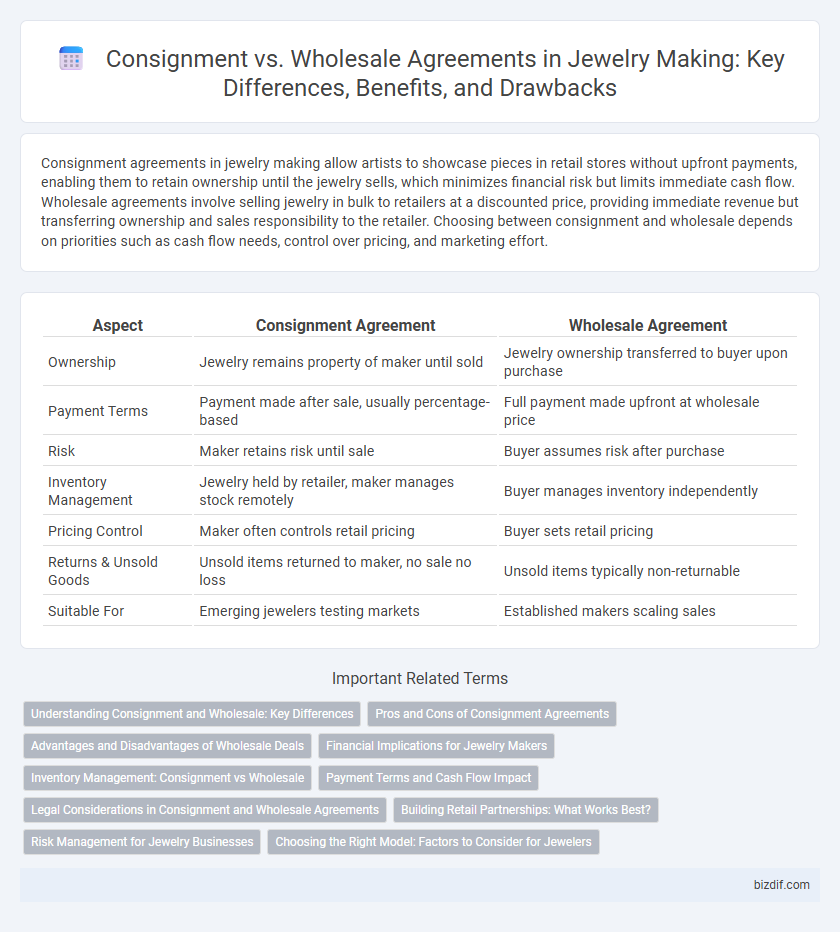Consignment agreements in jewelry making allow artists to showcase pieces in retail stores without upfront payments, enabling them to retain ownership until the jewelry sells, which minimizes financial risk but limits immediate cash flow. Wholesale agreements involve selling jewelry in bulk to retailers at a discounted price, providing immediate revenue but transferring ownership and sales responsibility to the retailer. Choosing between consignment and wholesale depends on priorities such as cash flow needs, control over pricing, and marketing effort.
Table of Comparison
| Aspect | Consignment Agreement | Wholesale Agreement |
|---|---|---|
| Ownership | Jewelry remains property of maker until sold | Jewelry ownership transferred to buyer upon purchase |
| Payment Terms | Payment made after sale, usually percentage-based | Full payment made upfront at wholesale price |
| Risk | Maker retains risk until sale | Buyer assumes risk after purchase |
| Inventory Management | Jewelry held by retailer, maker manages stock remotely | Buyer manages inventory independently |
| Pricing Control | Maker often controls retail pricing | Buyer sets retail pricing |
| Returns & Unsold Goods | Unsold items returned to maker, no sale no loss | Unsold items typically non-returnable |
| Suitable For | Emerging jewelers testing markets | Established makers scaling sales |
Understanding Consignment and Wholesale: Key Differences
Consignment agreements in jewelry making involve selling pieces on behalf of the maker, where payment occurs only after the item sells, reducing upfront costs and inventory risks for artisans. Wholesale agreements require sellers to purchase inventory at discounted rates, allowing immediate revenue but greater upfront investment and responsibility for unsold stock. Understanding these distinctions helps jewelers optimize cash flow, manage risk, and build strategic partnerships with retailers or distributors.
Pros and Cons of Consignment Agreements
Consignment agreements in jewelry making allow designers to showcase their pieces in retail stores without upfront payment, reducing initial financial risk and increasing market exposure. However, consignment often results in delayed revenue and potential inventory management challenges, as payment occurs only after items sell. Retailers benefit from lower inventory costs but may prioritize wholesale stock due to easier purchase terms, impacting consignment item visibility.
Advantages and Disadvantages of Wholesale Deals
Wholesale agreements in jewelry making enable artisans to sell products in bulk to retailers, often resulting in faster inventory turnover and higher volume sales. The advantage lies in predictable revenue streams and reduced marketing efforts, but disadvantages include lower profit margins due to wholesale pricing and less control over the retail presentation and final consumer experience. Wholesale deals may also limit brand exclusivity, as multiple retailers carry identical products, potentially diminishing perceived uniqueness.
Financial Implications for Jewelry Makers
Consignment agreements allow jewelry makers to retain ownership of pieces until sold, minimizing upfront costs but potentially delaying revenue and increasing inventory risk. Wholesale agreements provide immediate payment for bulk orders, improving cash flow but often requiring lower per-unit prices and larger production volumes. Understanding profit margins, payment terms, and inventory management is crucial to optimizing financial outcomes in both consignment and wholesale models.
Inventory Management: Consignment vs Wholesale
Consignment agreements allow jewelers to manage inventory with reduced upfront costs, as suppliers retain ownership until items are sold, minimizing risk of unsold stock. Wholesale agreements require purchasing inventory upfront, which demands higher capital investment but offers complete control over pricing and stock levels. Efficient inventory tracking systems help jewelers optimize stock turnover and cash flow in both consignment and wholesale models.
Payment Terms and Cash Flow Impact
Consignment agreements in jewelry making typically involve delayed payment until the piece sells, creating variable cash flow and potential liquidity constraints for artisans. Wholesale agreements require upfront payment or immediate invoicing, providing more predictable cash flow but increasing financial risk if inventory does not move quickly. Understanding these payment terms is crucial for managing working capital and sustaining business operations in the jewelry market.
Legal Considerations in Consignment and Wholesale Agreements
Legal considerations in consignment and wholesale agreements in jewelry making primarily involve clear terms on ownership, payment, and liability. Consignment agreements require explicit clauses defining the consignor's ownership until sale and responsibilities for loss or damage during consignment. Wholesale agreements focus on clear payment terms, delivery schedules, and warranties to protect both parties and ensure compliance with commercial laws.
Building Retail Partnerships: What Works Best?
Consignment agreements enable jewelry makers to showcase their pieces in retail stores without upfront costs, facilitating brand exposure and reducing inventory risks for retailers. Wholesale agreements involve bulk sales at discounted prices, providing immediate revenue and predictable cash flow for artisans but reducing per-item profit margins. Evaluating factors such as inventory control, cash flow needs, and long-term brand positioning helps determine the most effective approach for building sustainable retail partnerships.
Risk Management for Jewelry Businesses
Consignment agreements reduce upfront inventory costs but increase risks related to unsold stock and delayed payments, requiring meticulous tracking and insurance coverage for valuable pieces. Wholesale agreements provide immediate revenue with bulk sales but introduce risks of overproduction and potential returns, necessitating careful demand forecasting and contract clarity. Effective risk management in jewelry businesses involves balancing cash flow with inventory control while ensuring legal protections in both consignment and wholesale arrangements.
Choosing the Right Model: Factors to Consider for Jewelers
Jewelers must evaluate factors such as cash flow, inventory control, and risk tolerance when choosing between consignment and wholesale agreements. Consignment agreements allow jewelers to showcase a wider variety of pieces with minimal upfront investment but involve delayed payment and shared sales risk. Wholesale agreements provide immediate revenue and full ownership of inventory, optimizing cash flow but requiring higher upfront costs and storage capacity.
Consignment vs Wholesale Agreements Infographic

 bizdif.com
bizdif.com